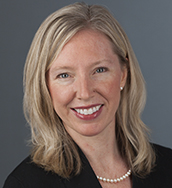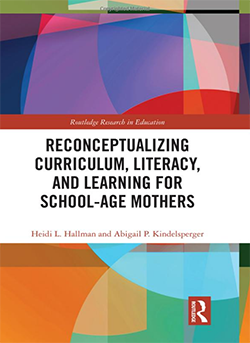Book aims to rethink how school-age mothers are taught, engaged with education
LAWRENCE — Any teacher can attest that reaching students is easier and their lessons more effective when they can relate to classroom subject matter. Yet for school-age mothers and other “at-risk” students, curriculum most often utilizes a deficit model, or fixing what students are deemed to be lacking. A University of Kansas professor has co-written a book that aims to rethink how school-age mothers are taught by deeply investigating programs that successfully engage this student population.
 “Reconceptualizing Curriculum, Literacy, and Learning for School-Age Mothers” explores questions of how curriculum and instruction intersect with the politics of teen pregnancy. Written by Heidi Hallman, professor of curriculum & teaching at KU, and Abigail Kindelsperger, a teacher at Wolcott School in Chicago, the book features intensive case studies of two high schools, one designed for expecting mothers or mothers of infants and one designated for “at-risk” students, including school-age mothers. The authors argue the schools offer a guide for how curriculum for this population of learners can be rethought by both engaging students with relevant materials and working to fill gaps in learning.
“Reconceptualizing Curriculum, Literacy, and Learning for School-Age Mothers” explores questions of how curriculum and instruction intersect with the politics of teen pregnancy. Written by Heidi Hallman, professor of curriculum & teaching at KU, and Abigail Kindelsperger, a teacher at Wolcott School in Chicago, the book features intensive case studies of two high schools, one designed for expecting mothers or mothers of infants and one designated for “at-risk” students, including school-age mothers. The authors argue the schools offer a guide for how curriculum for this population of learners can be rethought by both engaging students with relevant materials and working to fill gaps in learning.
For many years, high school students were prevented from attending public schools if they were pregnant or young mothers. Title IX made such segregation illegal in 1972, and schools dedicated to young mothers began forming shortly thereafter. The schools have curriculum tailored to school-age mothers, including classes in prenatal and infant care or teaching life skills. The case studies depicted in Hallman and Kindelsperger’s book showed where the schools excelled, in terms of literacy classes and using classroom materials that specifically related to the students’ life experiences. In some cases, the students read books with characters in similar life situations, or in writing exercises, they wrote a letter to their children. The material engaged the students and helped form their skills to speak to and learn about their experiences.
 “People sometimes ask, ‘Shouldn’t they have a rigorous curriculum?’ or ‘Isn’t drawing on their experiences just watering the curriculum down?’” Hallman said. “In the book, we argue if the curriculum is devoid of anything that can make the students see school’s value in their lives, students can lose interest in seeing school success as relevant to them. It can also lead to disengaged students.”
“People sometimes ask, ‘Shouldn’t they have a rigorous curriculum?’ or ‘Isn’t drawing on their experiences just watering the curriculum down?’” Hallman said. “In the book, we argue if the curriculum is devoid of anything that can make the students see school’s value in their lives, students can lose interest in seeing school success as relevant to them. It can also lead to disengaged students.”
Research has shown that students disengaged from school are more likely to drop out and that many students who become pregnant report being disengaged from school, also reducing their chances of finishing their education. The case studies highlighted in the book show how relevant curriculum not only engaged the students but helped them think about their futures, consider their pasts and be forward-thinking about their lives, their children’s lives, careers and plans to graduate. The writing assignments also showed how relevant material helped them address the politics of teen pregnancy.
“The students were acutely aware of the societal discourse of teen pregnancy,” Hallman said. “They talked about the ‘wrong girl’ or ‘wrong family’ narratives. The only counter to that might be the ‘stigma is wrong’ narrative. The students were able to speak back, using a ‘stigma is wrong’ narrative, to how they’ve been portrayed in the past.”
There is relatively little research into education and curriculum for school-age mothers, but it has shown that the traditional approach for the population is to focus on the students’ deficits and simply try to ensure they do not have gaps in their learning. While there is value in addressing deficits, the authors argue matching skill development with engaging curriculum and material is more effective. Such “skill scaffolding” can build bridges between education and their lives in meaningful, engaging ways, Hallman and Kindelsperger write.
While there are schools for young mothers throughout the country, most schools do not offer much support for the population, outside of day cares in larger schools. However, most high school teachers will at some point have a school-age mother in their classroom, Hallman said. Therefore, it is vital teachers know how to develop curriculum that can support and engage school-age mothers and other at-risk learners. The book further sheds light on the implications of this reality and how teachers, administrators and teacher educators can all play a part in making sure educators can provide the best possible education for school-age mothers.
The case studies in the book illustrate the importance of preparing teachers who are able to reach young people but are also adept at andragogy, or the practice of teaching adults, in which relating to the student’s life experiences is vital.
“I saw that these girls were in transition from children to adults and think that in our approach to education we need to consider that,” Hallman said. “I don’t think we’ve considered it fully in teaching during adolescence.”
Above all, educators need to be facilitators for the students and need to be able to reach students at their level and learn with and from them in culturally and socially relevant ways, the authors argue.
“Being a teacher in this context requires you to be able and willing to do that skill scaffolding and help students apply the knowledge they gain through that approach to their lives and to the real world,” Hallman said.